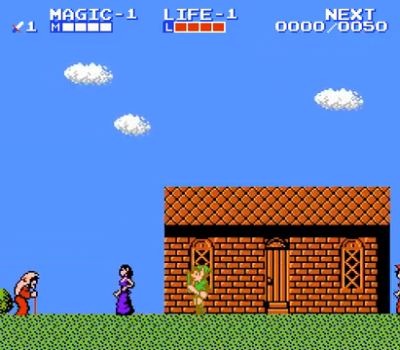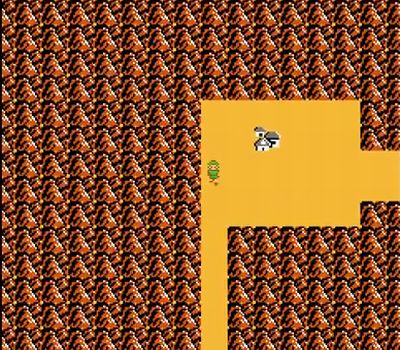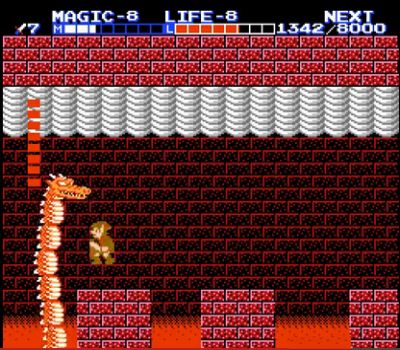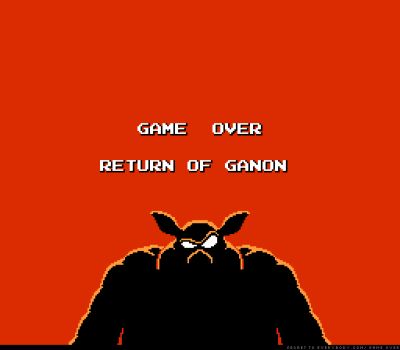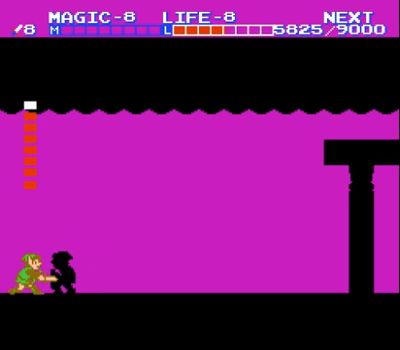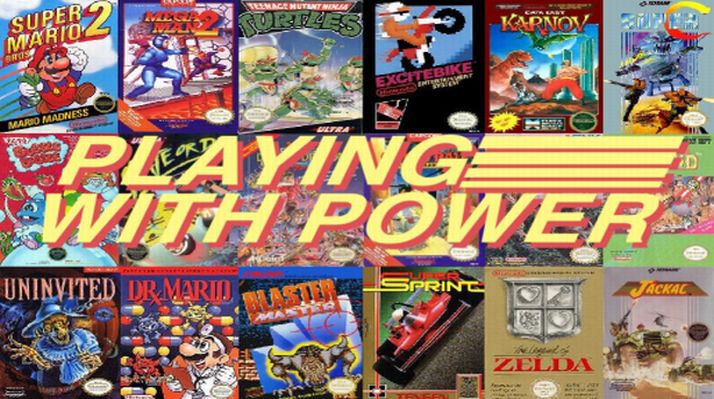 Welcome to another edition of Playing With Power. The review article that looks at all things Nintendo Entertainment System. Well, here we are at the 75th Playing With Power review. Who would have thought this would have made it to 25 let along 75? And this week, we take another leap into one of Nintendo’s biggest franchises. Only problem is, this one is often considered the black sheep of the family. And hey, since my first PWP focused on an NES black sheep, this is more than apropos. So let’s dive into Hyrule once more for high adventure with Zelda II: The Adventure of Link.
Welcome to another edition of Playing With Power. The review article that looks at all things Nintendo Entertainment System. Well, here we are at the 75th Playing With Power review. Who would have thought this would have made it to 25 let along 75? And this week, we take another leap into one of Nintendo’s biggest franchises. Only problem is, this one is often considered the black sheep of the family. And hey, since my first PWP focused on an NES black sheep, this is more than apropos. So let’s dive into Hyrule once more for high adventure with Zelda II: The Adventure of Link.
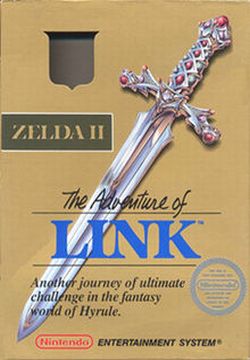 YEAR OF RELEASE: 1988
YEAR OF RELEASE: 1988
PUBLISHER: Nintendo
GENRE: Action RPG
The Legend of Zelda proved to be a massive worldwide hit for Nintendo, and would hold its place alongside Mario as the company’s biggest merch sellers. There was literally tons of Zelda merchandise out shortly following the NES game’s release. The commercial success was more than enough reasoning to warrant a sequel.
Shigeru Miyamoto quickly went under way with Zelda II’s development, acting as head producer of the game. However, he wasn’t just intent on simply redoing the same game again for Zelda II, so he would bring in an entirely new team to work on the game, including the first Nintendo directing project for Tadashi Sugiyama, who would go on to work on games like Pilotwings, the original Super Mario Kart, and even more recent works like Wii Fit Plus.
Zelda II was released to Japan in 1987 for the Famicom Disk System, and not too long after for the NES in 1988. Just like its predecessor, Zelda II was released in a gold cartridge which looks just as beautiful as the previous game. It was also another top seller for Nintendo, which would lead to more Zelda success. Even the addition to the upcoming Super Mario Bros Super Show cartoon.
But the reception for the game was mixed at best. Most people simply didn’t like the drastic change to the gameplay, feeling it was a little too different from the original. Pretty much like the backlash over Super Mario Bros 2, only this wasn’t just another game given a Zelda makeover like Mario 2 was. This was a straight from the ground up project. Either way, it earned black sheep status from most fans, and even Miyamoto would return to the style of the original Zelda when it came time for A Link to the Past for the Super Nintendo.
But does it really deserve such a black sheep status? Let’s press on further.
COVER STORY
Another great, simple Zelda box art, this time depicting Link’s sword instead of his shield from the previous box. I actually like this one a bit more. Maybe that has a lot to do with my preference of swords to shields, but either way, it’s still a pleasing cover for the game.
STORY
After defeating the dark wizard Ganon, freeing Zelda, and saving Hyrule, it looks like all is finally well. But all that comes to a halt seven years later, when our hero Link notices a strange marking on his hand. When he goes to Impa to seek an answer, she shows him to the North Castle, and to the original Zelda, who is in a deep coma. It turns out that this was a spell cast on her many ages ago by Zelda’s older brother, who was seeking the answer to the location of the pieces of the Triforce. When Zelda refused, she was put to a deep sleep by the wizard friend of her brother. She was placed in the North Castle as a reminder of the tragedy, and all daughters to the throne have since been named Zelda.
Believing the mark on Link’s hand is the key to finally freeing this Zelda from her slumber, Impa sends link on an adventure to place the six crystals into the six evil palaces of Hyrule, to which will open the door to the Great Palace, and the location of the Triforce of Courage. This would seem to be a cakewalk for Link, but there is one big snag. Ganon’s minions are still a bit peeved at Link for slaying their master, and are out to kill Link, and mix his blood into Ganon’s ashes, reviving their leader. Can Link survive this most incredible adventure?
GAMEPLAY
Zelda II: The Adventure of Link is a 1 player Platformer/RPG. You control Link as he must retrieve the Triforce of Courage to save the original Princess Zelda. He will have to travel to six castles in Hyrule to place the magical stones inside, that will open the door to the great palace. You control Link with the D-Pad, can attack with your sword with the B button, and jump with the A button.
The big difference right off the bat from the original is that this game is now primarily a side scroller. Link no longer has the majority of his arsenal from the original game either. Gone are the boomerangs, arrows, and bombs that made Link’s weapons epic. Now Link relies mainly on his sword, which at full health can shoot a blast at short range.
You’ll mainly sidescroll in towns, the castles and caves you traverse, or through random battles you’ll encounter on the map screen. When you veer off the dirt road into the grass, woods, or desert areas, you’ll be encountered by monsters, if you touch one, you’ll go into a random battle, where you’ll be in a platforming area fighting the monsters within. defeating certain monsters will add to your EXP. yes, there are actual experience levels in this game. At the end of a certain experience amount, you’ll be given the option to increase one of Link’s three experience areas, provided you have enough. These include his attack, his health, or his magic.
That’s right, another new addition to this game is the magic system. As you progress through the game, you’ll encounter the many towns within Hyrule. Each town usually have tons of characters to talk to, mostly with very little to really aid in Link’s quest. Most notably the infamous man who speaks “I AM ERROR!”. But other than places that heal your MP and HP, you will often have to do a sidequest for a towns person. These can be as easy as fetching water in a fountain, or having to trek through a mountain to find a lost child. Once these are done with, you will meet the wizard that lives in the house of the person you helped, and he will give you a magic ability.
These magic include a high jump, the ability to reflect blasts, a shield that changes your tunic and lets you take less damage, a health restore, and even the ability to turn into a fairy, which helps get across big gaps, and even be useful if you are out of keys in a dungeon. These take up a lot of MP, but you can earn more back through magic bottles dropped by enemies. Blue will give small increases, while red will refill entirely.
Similar to Zelda 1, Link will be able to find hearts that can add an extra hit point to his health, but also magic bottles that will add an extra magic box to his MP. These are scattered throughout Hyrule, and the key to victory in the game’s end does require you to find them all. Especially to really get the most out of your abilities throughout later parts of the game.
Now let’s get to the meat of the game, the dungeon crawling. You will have to find your way to one of the six dungeons in the game, and to win, you’ll have to beat the boss and place the crystal inside the shrine. But that’s not as simple as it sounds. You’ll have to deal with tons of dangerous enemies, from the deadly stalfos skeletons, or the infamously annoying ironknuckles, who can block your sword strikes with their shield. You have to find keys to open rooms, which can make the game very maze-like, and in later levels, very easy to lose track inside.
Even if you get through the castle, you still don’t destroy it if you’ve forgotten the item inside. Yes, each level has a certain tool that Link will need to continue in his travels. These often don’t add anything new to Link’s abilities (except maybe the hammer), but instead move the story further. These include a raft to take Link to the next part of the land, a whistle to get rid of a deadly beast, a gauntlet that helps Link break bricks, and a cross that can help Link see ghosts in a haunted town. You also can find a hammer that can break the large rocks that block paths, as well as a candle that lights up the dark caves.
So, this game actually sounds like fun, but what’s the kicker? What’s the one thing that really irks people about this game? Well, the one thing that does it in for people is the fact that the game works on a lives system. You get three lives to start, and with some of the perilous platforming you’ll do throughout the game, you’ll lose those lives quickly. You get game over, get introduced to one of the creepiest game over screens ever…
And will have to start the game AT THE VERY BEGINNING! Yes, just like Fester’s Quest, this game pulls the ultimate screw you, and have you trek to wherever you died at all over again. However, unlike Fester’s Quest, you do have a save feature that helps immensely, and don’t have to fully worry about a 4 hit life system. Plus, unlike Fester’s Quest, the game doesn’t really have any issues or cheapness that really causes your downfall.
It’s really all a case of how good you are at these games, as well as lots of practice. Plus, a really nice touch is that if you die in the last level, they do restart you at the front of the last level. Why that couldn’t occur in the rest of the game is beyond me, but it still is a much needed addition that would have helped this game a little.
So in your battles throughout Hyrule, you’ll face many a boss. These include horse head warriors, fire spewing dragons, mace wielding barbarians, and beam blasting wizards. What could possibly be the final challenge you may ask? Well the grand finale the game pits you one on one with your own shadow. And trust me, he can destroy you… if you aren’t just cheap, and duck down while constantly slashing at his knees in the corner. Do that, and you finish this game.
GRAPHICS
Graphically, the game looks wonderful. The world is very well designed, uses the limited palette to perfection, and while most castles do look similar in places, they are still very nice to look at. Enemy sprites are all epic looking, and quite intimidating for an eight bit game. Link’s sprite also looks very solid as well. It all makes for a game that is just as pleasing to the eye as the original
MUSIC
The music in this game is another top notch soundtrack for the Zelda series. There is a bit more variety in the soundtrack then the previous game, and nothing ever feels out of place. My personal faves from the soundtrack include the overworld theme (which I prefer in many ways over the original Zelda overworld tune), and the great palace, which just gives a great epic vibe. It’s definitely not a black sheep in the sound department, and is certainly worth a listen.
OVERALL THOUGHTS
Zelda II, to me at least, is hardly a black sheep. Does it stand out from the others in the franchise? Yes, very much so. But is it a bad game? Not at all. It has great gameplay, control, sounds, and graphics, as well as a tough but fair challenge. One that will definitely make you work for victory. And that victory is very satisfying. Hell, i actually Play Zelda II a lot more than the original, because it’s just more fun to me than the original. And that is no knock to the original, which is also a blast to play. Maybe it’s my preference to platformers, who knows?
What I do know is that I can see the reasons some dislike it, and can’t certainly say it’s perfect. But for me, I love it. It’s been one of my faves since I really got back into retro gaming, and it will always be one I treasure in the library of the great grey box. And if you are looking to give it a shot, I’d definitely say it’s an adventure that you will never forget.
RATING: Thumbs Up

